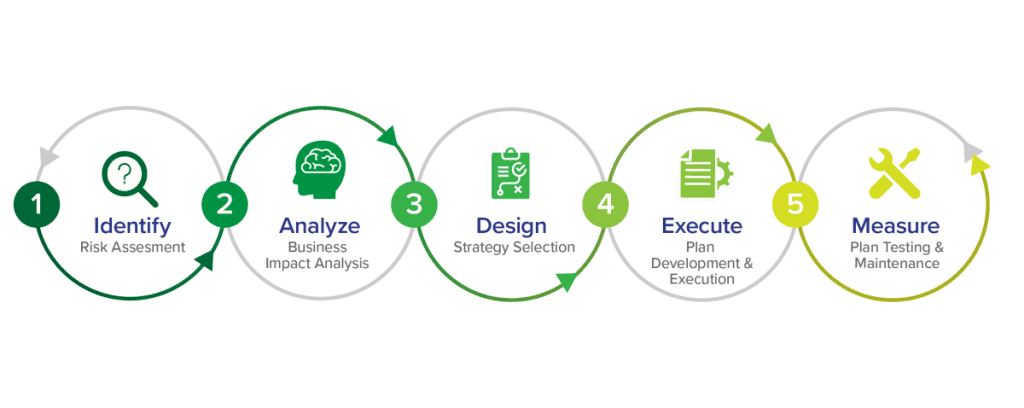
Unexpected downtime incurs serious costs to businesses dependent on effective and reliable IT infrastructure.
System downtime amounts to approximately $100,000 an hour for Fortune 1000 companies, according to an IDC report, but smaller businesses also take a serious hit. Not only does unexpected downtime incur direct costs, it can also tarnish your brand’s reputation.
To ensure your business is resiliant, you need a robust business continuity plan.
What Is a Business Continuity Plan?
A business continuity plan (BCP) goes beyond disaster recovery planning, which focuses primarily on restoring vital systems.
BCP is broader in scope, detailing how a company will continue to operate when faced with an unplanned disruption in IT services, taking into account all aspects of the business that could be affected, from business processes and human resources to assets and strategic partners.
In the event of unexpected downtime, a BCP outlines what needs to happen with regards to equipment and supplies, backup site locations, and data backups, as well as identifying and providing contact details for emergency responders, plan administrators, backup site providers, and other key personnel.
Business continuity disaster recovery is nonetheless a crucial component of a BCP. In case of unplanned disruptions to networks, personal computers, or servers, a BCP should inform on the best approaches for maintaining business operations, including manual workarounds, so downtime is kept to a minimum.
A comprehensive business continuity and disaster recovery plan will also include strategies for dealing with both short and long-term outages.
Each business’ BCP will differ, but they all tend to incorporate three features:
1. Uninterrupted operations
Put responses in place that ensure IT processes continue during unexpected as well as planned disruptions, such as scheduled backups.
2. High availability
Ensure businesses have access to applications irrespective of local failures, whether they’re located in physical facilities, software, or on-site IT infrastructure.
3. Disaster recovery
Have a separate data recovery site in the event of an irrecoverable loss at the primary location.
Why Are Business Continuity Plans Important?
Potential threats to the smooth running of a company’s operations are manifold, from cyberattacks and hardware failures to natural disasters.
What’s more, the risks have become even greater with increasingly integrated and distributed hybrid IT systems. While this extra complexity is essential for the modern-day demands of business, it means more potential vulnerabilities that can have a domino effect throughout a company’s IT infrastructure when things go wrong.
The consequences of not recognizing this and failing to craft a robust BCP are clear. Research courtesy of Unitrends indicates that 93 percent of businesses that lose their data for 10 days or more file for bankruptcy within a year.
Companies with a comprehensive BCP, on the other hand, experience reduced downtime, which translates to improved business continuity, resiliency, crisis management, regulatory compliance and crisis management. This helps companies to protect their reputation, retain clients, and lower overall operating costs.
A BCP is only as good as the business continuity analyst that develops it though.
Vertikal 6 is a leading provider of business continuity and disaster recovery as a service (BCDRaaS). From system-wide protection to individual files, Vertikal6 business continuity analysts weigh costs, risks and probabilities to develop backup and recovery solutions that prioritize business-critical and customer-facing applications.
Indeed, the various systems across a company’s IT infrastructure often have different levels of redundancy. V6 offers geo-redundancy for high-priority workloads alongside a proprietary backup and recovery platform composed of the latest technologies engineered to work seamlessly across cloud and on-site environments.
V6 business continuity consultants work with companies to develop the best solution to keep applications and processes operational while protecting all your data, from individual files and virtual machines to complex sets of analytic data.
Key Components of an Effective Business Continuity Plan

1. Guide disaster recovery teams
An effective business continuity strategy needs to provide step-by-step instructions to recovery teams when an unplanned disruption occurs. This should take the form of a hard-copy document that’s clear and easily accessible by the relevant persons.
2. Identify and assess risks
The likely causes of an unplanned disruption need to be outlined and the threat level that each poses made clear.
3. Analyze the likely impact of an unplanned disruption
Once risks are identified, a BCP, with the input of a business continuity analyst, should then determine the likely impact in terms of service disruption and financial cost. This will help inform other business continuity strategies concerning budgeting, restoration timelines, and intervention prioritization.
4. Establish emergency communications
Personnel responding to an unplanned disruption will have multiple questions regarding communications. A BCP should have prepared answers at hand that detail who communicates with employees, customers, media, and stakeholders and what they need to say.
5. Assign disaster recovery team responsibilities
The disaster recovery team coordinates and implements a substantial part of the BCP. It should therefore outline who exactly is on the team, their contact information, the organizational structure, and what each member’s respective roles are.
6. Locate critical assets and data
In an emergency, it’s imperative that recovery teams can quickly locate where company assets like critical data and backup resources like workstations are located. This means recovery teams can get to work in the absence of IT staff.
Furthermore, the BCP should detail where and how these assets can be moved and if there is reserve office space that can be used at short notice for such purposes.
7. Identify weaknesses and propose solutions
An effective BCP requires regular evaluations to assess its relevance and determine whether there are any gaps. Ensuring business continuity during an unplanned disruption necessitates ongoing reviews as circumstances change and new risks may emerge.
Once identified, work out possible solutions and assess their viability with the help of a business continuity analyst. If it proves effective, integrate the new procedure into the BCP.
8. Advise on preventative measures
A BCP provides guidance to recovery teams and reassurance to stakeholders that all possible measures are in place to avoid costly unplanned disruptions. To put them at ease, summarize these measures so that all interested parties are aware of the tools, technologies, manpower and protocols that have been established to minimize the risks posed.
Start here to level up your IT.
Click below or call our Rhode Island headquarters at: 401-825-4400.










